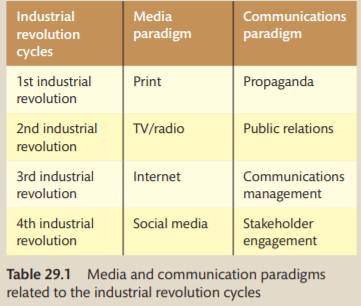Postmodern corporate communications: communicative paradigms and economic progress
As outlined in Table 29.1, each phase of industrialisation has been accompanied by a key medium which enabled and promoted the provision and distribution of information relevant to the respective form of economic activity. Whereas posters and newspapers printed on rotary presses were the media of the first industrial revolution of the steam engine and the railway, radio and television created mass-media communication channels for the second industrial revolution powered by automobiles, electro-technology and chemicals. With the advent of the internet, we have witnessed the increasingly rapid development of another defining medium in economic history – and a third industrial revolution.
Despite the corporate communications discipline evolving and maturing over more than a century, a process which led both to the marked professionalisation of work processes and a move away from the concept of communications as a purely transmissional tool, it is nonetheless still associated with a working method which focuses on communication ‘from the inside out’. This traditional, unilateral understanding of the responsibilities of corporate communications is, however, no longer in keeping with the requirements in the first half of the twenty-first century, regardless of the professionalism with which it is practised. The fourth industrial revolution, which is accompanied by social media as the defining mass media, requires stakeholder engagement as the new corporate communications paradigm.
Table 29.1


